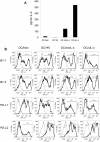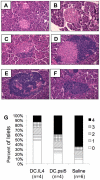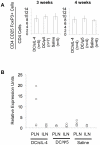Dendritic cells transduced to express interleukin 4 reduce diabetes onset in both normoglycemic and prediabetic nonobese diabetic mice
- PMID: 20686610
- PMCID: PMC2912295
- DOI: 10.1371/journal.pone.0011848
Dendritic cells transduced to express interleukin 4 reduce diabetes onset in both normoglycemic and prediabetic nonobese diabetic mice
Abstract
Background: We and others have previously demonstrated that treatment with bone marrow derived DC genetically modified to express IL-4 reduce disease pathology in mouse models of collagen-induced arthritis and delayed-type hypersensitivity. Moreover, treatment of normoglycemic NOD mice with bone marrow derived DC, genetically modified to express interleukin 4 (IL-4), reduces the onset of hyperglycemia in a significant number of animals. However, the mechanism(s) through which DC expressing IL-4 function to prevent autoimmune diabetes and whether this treatment can reverse disease in pre-diabetic NOD mice are unknown.
Methodology/principal findings: DC were generated from the bone marrow of NOD mice and transduced with adenoviral vectors encoding soluble murine IL-4 (DC/sIL-4), a membrane-bound IL-4 construct, or empty vector control. Female NOD mice were segregated into normoglycemic (<150 mg/dL) and prediabetic groups (between 150 and 250 mg/dL) on the basis of blood glucose measurements, and randomized for adoptive transfer of 10(6) DC via a single i.v. injection. A single injection of DC/sIL-4, when administered to normoglycemic 12-week old NOD mice, significantly reduced the number of mice that developed diabetes. Furthermore, DC/sIL-4, but not control DC, decreased the number of mice progressing to diabetes when given to prediabetic NOD mice 12-16 weeks of age. DC/sIL-4 treatment also significantly reduced islet mononuclear infiltration and increased the expression of FoxP3 in the pancreatic lymph nodes of a subset of treated animals. Furthermore, DC/sIL-4 treatment altered the antigen-specific Th2:Th1 cytokine profiles as determined by ELISPOT of splenocytes in treated animals.
Conclusions: Adoptive transfer of DC transduced to express IL-4 into both normoglycemic and prediabetic NOD mice is an effective treatment for T1D.
Conflict of interest statement
Figures






Similar articles
-
Tissue-targeted therapy of autoimmune diabetes using dendritic cells transduced to express IL-4 in NOD mice.Clin Immunol. 2008 May;127(2):176-87. doi: 10.1016/j.clim.2007.12.009. Epub 2008 Mar 12. Clin Immunol. 2008. PMID: 18337172 Free PMC article.
-
Dendritic cells transduced to express interleukin-4 prevent diabetes in nonobese diabetic mice with advanced insulitis.Hum Gene Ther. 2003 Jan 1;14(1):13-23. doi: 10.1089/10430340360464679. Hum Gene Ther. 2003. PMID: 12573055
-
Dendritic cell-expanded, islet-specific CD4+ CD25+ CD62L+ regulatory T cells restore normoglycemia in diabetic NOD mice.J Exp Med. 2007 Jan 22;204(1):191-201. doi: 10.1084/jem.20061631. Epub 2007 Jan 8. J Exp Med. 2007. PMID: 17210729 Free PMC article.
-
Passive transfer of flt-3L-derived dendritic cells delays diabetes development in NOD mice and associates with early production of interleukin (IL)-4 and IL-10 in the spleen of recipient mice.Clin Exp Immunol. 2003 Dec;134(3):388-95. doi: 10.1111/j.1365-2249.2003.02308.x. Clin Exp Immunol. 2003. PMID: 14632742 Free PMC article.
-
Effective treatment of established murine collagen-induced arthritis by systemic administration of dendritic cells genetically modified to express IL-4.J Immunol. 2001 Mar 1;166(5):3499-505. doi: 10.4049/jimmunol.166.5.3499. J Immunol. 2001. PMID: 11207309
Cited by
-
Immature Dendritic Cell Therapy Confers Durable Immune Modulation in an Antigen-Dependent and Antigen-Independent Manner in Nonobese Diabetic Mice.J Immunol Res. 2018 Feb 14;2018:5463879. doi: 10.1155/2018/5463879. eCollection 2018. J Immunol Res. 2018. PMID: 29651443 Free PMC article.
-
RBP4 activates antigen-presenting cells, leading to adipose tissue inflammation and systemic insulin resistance.Cell Metab. 2014 Mar 4;19(3):512-26. doi: 10.1016/j.cmet.2014.01.018. Cell Metab. 2014. PMID: 24606904 Free PMC article.
-
Role of Interleukins in Type 1 and Type 2 Diabetes.Diagnostics (Basel). 2025 Jul 30;15(15):1906. doi: 10.3390/diagnostics15151906. Diagnostics (Basel). 2025. PMID: 40804870 Free PMC article. Review.
-
Exosomes in the Pathogenesis, Diagnosis and Treatment of Pancreatic Diseases.CellR4 Repair Replace Regen Reprogram. 2014;2(1):e807. Epub 2014 Feb 8. CellR4 Repair Replace Regen Reprogram. 2014. PMID: 33869660 Free PMC article.
-
Regulation of immune responses by extracellular vesicles.Nat Rev Immunol. 2014 Mar;14(3):195-208. doi: 10.1038/nri3622. Nat Rev Immunol. 2014. PMID: 24566916 Free PMC article. Review.
References
-
- Anderson MS, Bluestone JA. The NOD mouse: a model of immune dysregulation. Annu Rev Immunol. 2005;23:447–485. - PubMed
-
- Lo J, Clare-Salzler MJ. Dendritic cell subsets and type I diabetes: focus upon DC-based therapy. Autoimmun Rev. 2006;5:419–423. - PubMed
-
- Cameron MJ, Arreaza GA, Zucker P, Chensue SW, Strieter RM, et al. IL-4 prevents insulitis and insulin-dependent diabetes mellitus in nonobese diabetic mice by potentiation of regulatory T helper-2 cell function. J Immunol. 1997;159:4686–4692. - PubMed
Publication types
MeSH terms
Substances
Grants and funding
LinkOut - more resources
Full Text Sources
Other Literature Sources
Medical

